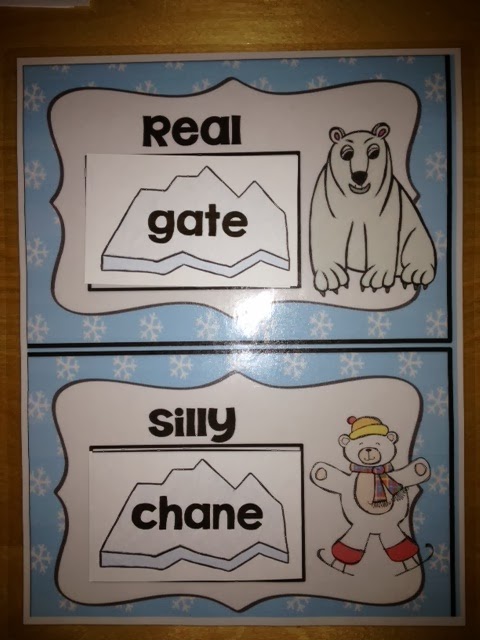As you might remember, this year I'm teaching reading for students in k-3. Today I want to show you what my week looks like with my first grade students. (I'll show k, 2, and 3 during another post).
Here is a sample of my lesson plans:
(Earlier in the year there was a phonological awareness section)
1. Phonics: I always start with a phonics lesson. I review or introduce the skill and do some modeling first. Here, they are practicing sounding out words with the silent e.
We also did a big pile of real and nonsense words.
Here's a favorite of mine. They cover the snowflakes with different onsets to make as many words as they can. I do this first as a group activity where I model sounding out different matches. Then we do several as a group and finally, they do a bunch on their own.
2. Sight words
Most of my students really struggle with memorizing those sight words so I always try to dedicate time to them. I usually pick a few words to focus on each week, but no more than 2 or 3. Here is a little worksheet I made for them to search for the word there. I really love this font by Carrie because it shows the shape of the word.
Click here to get this freebie, along with a few others.
They love using beads to make words. I usually have the beads mixed up and they put the beads in order, read the word, then do it again and again.
Classic magnetic letters is always a winner! They had to put the letters in order, read the word, then write the word 3 times. Then we rotated seats.
3. Fluency/ Shared Reading Activities
Depending on how much time I have, this activity may vary. I use these "fluency strips" to work on fluency (obviously), and to focus on our sight word of the week. I also try to integrate the phonics skill we're working on (some fluency strips with lots of silent e words, for example). Here, I used the words come and/or down in all of the strips. Again, trying to get those sight words mastered! (On this day, they all had to make the word come or down with their beads then read one fluency strip). They practice their fluency strip until they are, well, fluent. Then they read it to the group.
I ended up copying these onto blue construction paper.
Here's a close up of one (that isn't on blue paper):
When I have a little more time, I love to write short stories or poems to use for shared reading. I try to use poems or stories with my sight word(s) of the week OR my phonics focus. They are not going to be winning any literary awards any time soon, but they get the job done. I try to make sure there is some type of story in there so we can work on comprehension too. :)
(The Pet is part of the freebie download above)
The story on the left uses the words come and down a lot! I ended up using this poem for two weeks because that's how long it took them to be fluent. We had plenty of activities to do:
- We visualized and drew what was happening
- We searched for quotation marks and periods
- We spent a day working on our cat and dog and narrator voices (because the characters are a cat and a dog).
- We searched for the sight words and we searched for inflectional endings
The story on the right uses the words there and where. This is the student's copy. She is highlighting the sight words of the week. I hope to make a pack of these sometime in the future.
4. Guided Reading: This is the part where students get to practice all the strategies we've been working on. During guided reading, we focus on a particular strategy.
I start by reading the title and set a purpose for reading. We discuss any vocabulary, as needed. Then the kids "whisper read" first, then we read together. Sometimes I give them sticky notes to use, depending on what our focus is for the day. They love any chance to use a sticky note. :) After reading, we always do a quick comprehension activity (usually questions or a graphic organizer that helps illustrate a skill). I try to focus on a comprehension skill each week, but that doesn't always work out.
5. Writing is not on my official lesson plan template, but it should be! I ALWAYS do writing in some way during my lesson, whether it be practicing writing complete sentences or response to reading. It is usually a small writing task, but so important.
I hope this post helps you plan your reading time with your first grade students! I'd love to hear what you do with your firsties. :)
Head on over to my blog to see more pictures and read in much more detail with even more examples.

















No comments:
THANKS for taking the time to leave us a comment!